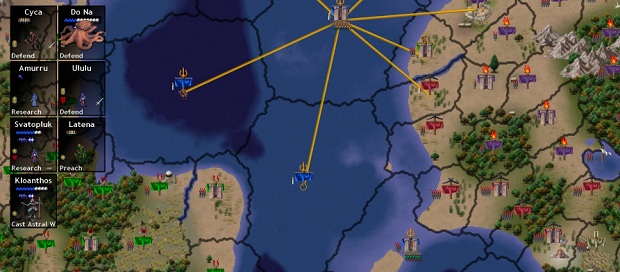The Complex God: Dominions 4
The great pretenders
If turn-based strategy games tickle your fancy and you've never heard of the Dominions series, it might be best to turn away now. That is if you don't want to spend the next couple of days poring over a hefty manual, the next couple creating a succession of pretender gods, and the following weeks and months attempting to ascend to a Position of Ultimate Power. I dabbled briefly with Dominions 3 but since the release of the fourth instalment a few days ago, I've lost most of my self to the game. I'll write much more as soon as I've managed to win the game while playing as a totem pole, but for now, I shall compile a brief list of reasons as to why you may be interested, whether you've played Dominions 3 or not.
The manual for Dominions 4 really is enormous and there are supplemental guides for every sort of spell in the game as well. That's necessary because there are more than eight hundred of the things, from basic combat spells to world-sundering global effects. Here are some more numbers:
2,000+ monsters
75 nations
300 magic items
Infinite maps
Infinite Gods (or near enough)
Infinite Gods! It's that kind of game, one in which you probably won't see everything in a lifetime, never mind a single campaign. Indeed, you won't see anything near a tenth of the total in one playthrough because every nation has a unique set of creatures to its name and you can't stick them all on one map.
When the game begins, players choose a nation and create a pretender, which is their avatar in the world and the item/creature/person that they are attempting to elevate to godhood. Nations range from Lovecraftian underwater cities to Arthurian kingdoms and pretenders can be anything from a lich lord to an inanimate fountain of blood. The variety is astounding and every early decision has an impact on later strategies.
Creating a god is quite tricky. Feels like more of a responsible task than creating a dwarf cleric, although beards can be just as important. Who among us would worship a totem pole that didn't boast a particularly impressive Hulihee?
Once on the map, the game settles into a pattern of conquest and development that is somewhat easier to get a handle on than the creation process, although there are still a great deal of options and the interface, though not actively unfriendly, can occasionally hide its secrets too well. Interfaces shouldn't really have secrets at all.
The biggest addition to this sequel is a co-operative multiplayer mode built around the concept of Disciples - for each team, one player controls the pretender god while the others control powerful prophets. I haven't had a chance to try it yet but intend to recruit at least one node of the Hivemind to my cause. Along with Disciples, the game also adds Thrones of Ascension, specific objectives that are optionally scattered across the map. As well as providing a stronger focus for short-term conquest, they create potentially game-changing effects when seized. There are also new terrain types, contributing to complex random maps, and additional items, spells, nations and unit types.
I'm thoroughly absorbed, only surfacing to write posts like this and to change my music playlist occasionally. I find that Dominions suits ambient electronica, unless I'm playing (as currently) an all-consuming sylvan mother-tree, in which case I opt for a spot of Matt Berry's folk-fear.
Dominions 4 is out now. I'll tell you exactly wot I think as soon as possible.

